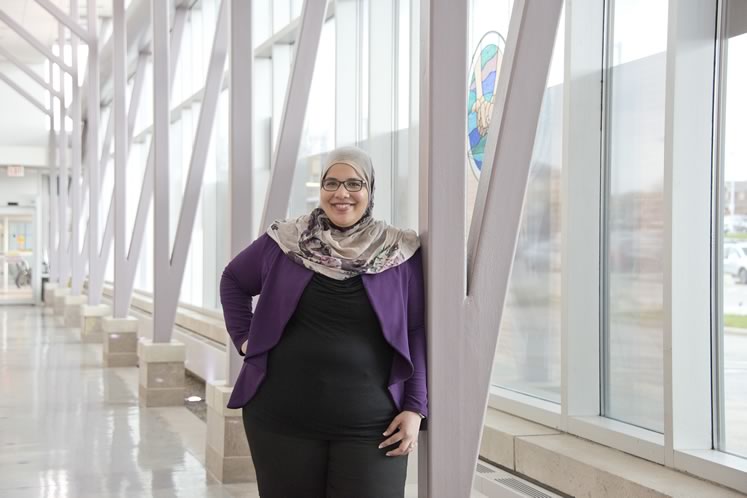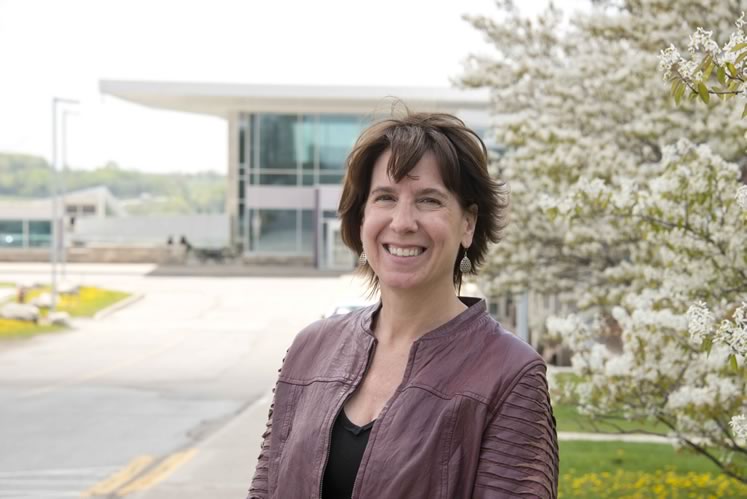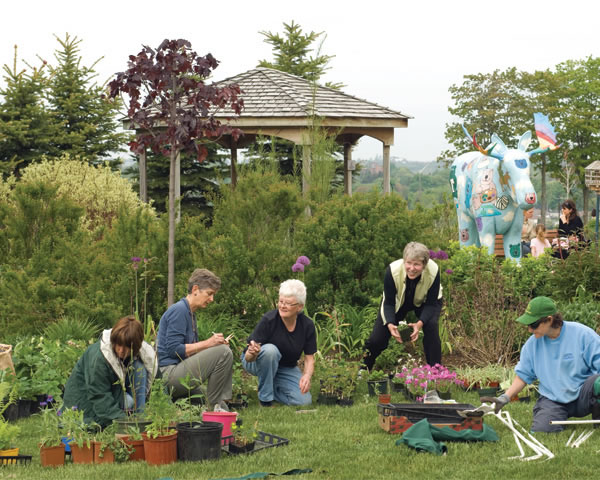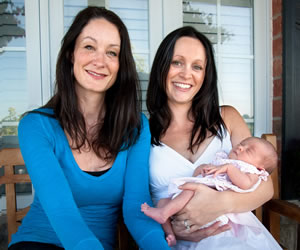Headwaters Health Care Centre Faces the Future
In the face of the province’s restructuring of health care, our Headwaters hospital is poised to emerge as the kind of community hub Ontario needs.
The day after the Ontario government announced its new People’s Health Care Act in February, Stacey Daub was working with staff at Headwaters Health Care Centre to put the finishing touches on the hospital’s new strategic plan. As CEO, Daub was still trying to absorb the local implications of the government’s radical restructuring of health care delivery, when her email dinged. The message was from the office of the Ministry of Health and Long-Term Care. Health minister Christine Elliott had heard Headwaters was a fine example of the kind of patient-centred, integrated health service that was a key goal of the new legislation. So she would be coming to visit.
Daub and her team were more than ready to strut their stuff. When the minister and her entourage arrived just two days later, they were greeted in the hospital boardroom by 24 people including physicians and nurses, paramedics, personal support workers, and representatives from child and family services, mental health and other agencies. Pulling them together on such short notice was itself a testament to the co-operative spirit shared by every individual around the table.
The new legislation set out the broad outlines of a major structural shake-up, largely aimed at cost efficiencies and fulfilling Premier Doug Ford’s election promise to “end hallway medicine.” Since the act was passed there has been a dizzying array of further announcements about service amalgamations and cost-cutting measures. But so far, very little detail about how it will all play out in practice.
To start, the 14 Local Health Integration Networks, the regional bodies that debuted in 2007, are out, to be replaced by a super board called Ontario Health. It will encompass six existing organizations including Cancer Care Ontario and Trillium Gift of Life Network. The 12-person board will have the power to transfer, merge or eliminate a broadly defined list of health-related services.
In addition, between 30 and 50 Ontario Health Teams will be established across the province. Formed by local health providers, they will be charged with organizing and delivering local services under one umbrella. Ideally, patients will access a single team for all their health care needs and that team will design a local health system tailored to its community.

Headwaters chief of staff Dr. Somaiah Ahmed says the new health care legislation “almost empowers us to do the work we’re already doing. It’s giving communities back the ability to plan their own course, and we’ve been writing our own story for years.” Photo by Pete Paterson.
With so much still up in the air, it is on this latter provision that staff at Headwaters have focused their attention. Seeing the parallels between the goals of the hospital’s strategic plan and the objectives of the new legislation, chief of staff Dr. Somaiah Ahmed says, “It almost empowers us to do the work we’re already doing. It’s giving communities back the ability to plan their own course, and we’ve been writing our own story for years.”
The hospital and its community partners have already completed the first step in applying to be an Ontario Health Team. There are more steps to go, with a final decision likely months away, but staff are hopeful a successful application will provide them with a mechanism to move forward confidently with initiatives already well underway and open the possibility of others.
One of those initiatives is to improve the hospital’s bustling emergency department where Ahmed practises. It is in desperate need of more space. Built to accommodate 22,000 patients per year, it now sees more than 40,000. The big dream is to increase the footprint, but “in the meantime, we’re going to make the best of our space, so we can continue to care for our community,” Ahmed says.
Over the past couple of years, a fast-track area has been created for less acute cases to flow through more quickly without holding up more serious cases. The hospital has also increased signage and worked with staff to better inform patients of timing and procedures. And it reinstated volunteers to help patients navigate the emergency department. (Volunteers had been removed to prevent unnecessary risk during worldwide concerns over Ebola.) Renovations, financed by donations, are scheduled to begin this year (pending ministry approval) to allow for better flow and additional beds.
“Nobody, when they’re sick, wants to wait a long time,” says Ahmed. Headwaters consistently averages in the top 10 per cent of Ontario hospitals with the shortest wait times.
Just as in the ED, a growing population is outpacing other local health services. The window in Stacey Daub’s office looks across to a brick building that used to house nearly every primary care physician in the region. It was built in 2003 as part of a major recruitment effort to entice family doctors who were in short supply here at the time. Today 36 family doctors are part of the Dufferin Area Family Health Team working from seven clinics in Orangeville, Grand Valley and Shelburne.
When the hospital was built in 1997, the combined population of Dufferin County and the Town of Caledon was 85,000. As of 2016, the population had increased to 127,500. And that number is projected to grow to nearly 190,000 in little more than a decade. Within the region, Shelburne is the second fastest-growing town in Canada.
The hospital also serves Erin and other surrounding regions. Last year nearly a fifth of both emergency and inpatients came from outside the borders of Dufferin and Caledon. “There are no boundaries to access to care,” says Daub. “Our patients are local residents, people visiting the area or just passing through, and others in surrounding communities who come specifically for our obstetrical program.” (Upwards of a thousand babies a year are delivered here every year.)

Headwaters Health Care Centre CEO Stacey Daub has been working on patient service transitions for a decade: “Imagine if you could eliminate those transitions, if it truly was all within one system.” Photo by Pete Paterson.
Built to accommodate 102 beds, the hospital is funded for only 73. Although patient stays are shorter than they were two decades ago, Headwaters averages 90 to 110 per cent occupancy, well above the international standard of 80 per cent. Last year Headwaters, along with other medium-sized hospitals, pressed the government to address their current “unpredictable and insufficient” funding.
“When you’re bigger, you can have more variability in your volumes and you’ll always have the basics covered,” says Daub. To provide 24-7 emergency care, for example, a certain level of staffing is required. Larger hospitals have the patient numbers to support that. “Here our volumes go up and down – one day we may have 70 visits, another day 140, so the funding formula tries to fund it at a much lower level,” says Daub.
While the government has acknowledged the funding model is problematic, its new budget contained nothing to resolve it. Asked why not, a government spokesperson replied by email: “Further discussions are underway to explore medium- and long-term refinements to the funding model for medium-sized hospitals in order to ensure alignment within an integrated, patient-centered health care system.” In other words, it might change, but not yet.
Until that happens, “hallway medicine” remains an occasional problem – during the recent flu season, for instance – that Headwaters has been trying to alleviate internally, long before it became a political talking point.
“A lot of the time, patients end up in hallways because the wrong patient is in a hospital bed,” Ahmed says. The hospital has focused on getting patients home, into long-term care or a retirement home if they’re able. “People talk about the gem of a unit we have on E-wing,” says Ahmed of the hospital’s rehabilitation program. “We’ve helped people that traditionally wouldn’t have been able to go home, go home.” The achievement is particularly notable because this region has among the lowest per capita funding for home care in the province.
Since the release of its budget in April, program cuts have flowed out steadily from Queen’s Park, and reaction across the province has been swift and loud. On April 30, thousands of people rallied outside the legislature to protest policies they see as a savage assault on health services.
Safe injection sites and all funding for the College of Midwives of Ontario were on the chopping block, budgets for eHealth Ontario and the Health System Research Fund were slashed, and funding for mental health services has been downgraded from a $2.1 billion allotment over four years by Kathleen Wynne’s government, to $1.9 billion over 10 years under Doug Ford’s. Subsequent government announcements about new funding for mental health has been criticized by the Ontario Health Coalition as no more than reannouncements of the same pool of decreased funding.
The new budget did provide an overall increase in hospital funding of 2 per cent per year – but that is barely the rate of inflation and doesn’t take into account population growth. Last year, the hospital’s $71.8-million budget represented an annual increase of 4.5 per cent, related mostly to inflation. The province provided 70 per cent of its total operating costs. (Provincial funding covers salaries, building operations, diagnostic testing and the cost of a patient occupying a bed, but most equipment, including everything from the physical bed a patient occupies to the IV poles set up beside it, has to come from the community through fundraising and donations.)
In early June, two months into its current fiscal year, and three months after the health minister’s whirlwind consultation, Headwaters received notice its provincial funding would increase by only 0.7 per cent.
“This was below what we had hoped for,” says Daub. “We are very active in our follow-up with government for a permanent funding adjustment around Headwaters and the broader issue around medium-sized hospitals.”
What will change is the way the hospital receives its funding. Currently the Central West LHIN distributes provincial funding and co-ordinates among various defined health care providers in the region. When the LHINs were created in 2006 under Dalton McGuinty’s Liberal government, the idea then, as now, was to connect the disparate components of the health care system under a local organization that understands the unique environment of the region.
Maria Britto, former chair of the Central West LHIN, credits the organization for a number of advances in local health care delivery. In response to conversations with patients, for example, it brought in a telemedicine program. And the new Musculoskeletal Central Intake, Assessment and Management program at Headwaters came out of a partnership between the local LHIN and William Osler Health System in Brampton. Because of the organization’s roots in the community, “we did a lot, we found out a lot, we uncovered a lot,” Britto says, underscoring the importance of the network’s “local” focus.
But the LHINs have been criticized for adding another layer of bureaucracy – and an expensive one at that. Last year executive compensation for the Central West LHIN came in at about $1 million. Now that the LHINs are headed for the dustbin, it remains to be seen whether the combination of the new super board and local health teams will produce administrative savings. And if so, whether those savings will be redirected to frontline care.
In the absence of details, skeptics abound. But perhaps the loudest opposition has come in response to cuts affecting public health units, responsible for programs related to air and water quality, disease and infection outbreaks, healthy eating, smoking cessation and the like. In 2018, the health ministry along with the Ministry of Children and Youth Services generally provided 75 per cent of health unit funding, with municipalities making up the rest.
The government initially proposed to shift the ratios to 70:30 this year and to 60:40 after that. The ratio in Toronto was to drop to 60:40 and then 50:50. Toronto Public Health estimated it would lose more than $1 billion over the next decade (though the government disputes this figure). While hospitals deal with critical care, the regional public health units focus on preventive health care, so outcomes are more difficult to quantify. But councillor Joe Cressy, chair of the Toronto Board of Health, minced no words in predicting the result of the funding shortfall: “People will die.”
Locally, the response of Chuck Ferguson, spokesperson for Wellington-Dufferin-Guelph Public Health, was more moderate. “We do not anticipate any funding cuts,” Ferguson says. “Our municipal partners currently fund us at a higher rate than other health units receive from their municipalities. The province has indicated they are going to fund us at the current level.”
In Wellington County, which includes Erin, treasurer Ken DeHart is not so sure. In 2018, 66 per cent of the operating budget of WDG Public Health came from the province. The remainder was made up by the municipalities the unit serves, based on population. Wellington County contributed 12 per cent, Dufferin County 7 per cent and the City of Guelph 15 per cent.
Stressing his numbers are “very preliminary guesstimates,” DeHart expects potential reductions in provincial funding to WDG Public Health of between $1.3 million and $3 million annually. For Wellington County that could mean making up between $420,000 and $920,000, either by cutting services or raising municipal property taxes.
Now the municipalities have been given another year to decide if and how they will contribute the extra funds. In late May, the province announced it would delay the funding shift for a year to allow municipalities more time to find room in their budgets for the added cost.
DeHart says the treasurers of Wellington, Dufferin and Guelph will meet with WDG Public Health in mid-June to assess their options. In the meantime, the difference in the responses of Ferguson and DeHart may be an indication of just how vague the situation remains. “We really don’t know yet because we haven’t been given any level of detail,” says DeHart.
But another wrinkle could complicate those calculations. The province has also announced it will amalgamate Ontario’s 35 public health units into 10. WDG will merge with the Peel, Halton and Waterloo units, making it the largest health unit in Ontario. Ferguson says WDG has received no further direction from the province, but notes the merger idea is not new. WDG Public Health’s CEO and medical officer of health, Nicola Mercer, sat on the Expert Panel on Public Health which advised the previous government to amalgamate public health into 14 units, only a few more than the Ford government currently plans.
Meanwhile, as Headwaters waits for the government to play its cards, the hospital and its partner organizations are keeping their eye on the prize. Because the region is a tight-knit community with health services that already co-operate well together, they believe Headwaters can be an incubator for models of the patient-centred, integrated service the province says it wants. Stacey Daub, appointed Headwaters CEO in early 2017, has been working on patient service transitions for a decade – breaking down the barriers between home care, hospitals and specialists. “Imagine if you could eliminate those transitions,” she says, “if it truly was all within one system.”
Amid the uncertainty, the hospital’s new three-year strategic plan is more tied to ethos than to dollar amounts and organizational structure. Perhaps most notably, the plan is a lot about listening – to patients, staff and community members. Among its new initiatives the hospital has established a patient family engagement group to better hear from and respond to their needs. The group currently includes 13 community members who have had some recent personal interaction, for better or worse, with the hospital.
The engagement group follows on the heels of the Imagine Headwaters campaign, a community consultation exercise undertaken last year and involving more than 3,000 residents, partners and staff members. Perhaps not surprisingly the consultation found that patients and their families want to be more involved in making decisions and having control of their care, and making that happen is a key strategy in the new plan. The plan also calls for better use of technology to communicate with patients and partner organizations, including unifying electronic health records (so patients aren’t forced to repeat their medical history at every visit), and further developing telemedicine, already being used for consulting on cardiac rehabilitation.
The survey also found that residents want more services closer to home. As a result, the hospital has identified priority service improvements in diagnostics, mental health, pediatrics and cancer care. These will build on the opening of the new Ambulatory Care wing in late 2017. The 8,700-square-foot addition cost $14 million (a little more than half came from the ministry, the rest through community fundraising) and was the first expansion since the hospital opened. It houses orthopedics, plastics and a new dialysis unit, as well as a new chemotherapy area that allows the hospital to offer chemotherapy with more flexible timing and closer to patients’ homes.
Though many longtime residents still think of Headwaters as their “new” hospital, the 20-year-old building needs significant renovations, so the plan calls for the continuation of updates both to improve the delivery of care and provide a welcoming environment. The addition of another operating room and expansion of the pre- and post-surgical recovery areas were completed in 2018. Renovations to the main lobby, designed to make it safer, more accessible and convenient, are scheduled to begin this year.
Throughout the strategic plan, the theme of patient-centred, integrated services runs like a mantra. Although the release of Headwaters’ strategic plan follows closely on the announcement of the new legislation, there’s plenty of evidence that its emphasis on integration is more than an overlay to appease the province – that it is, in fact, an approach already deeply embedded in the culture of local health services.
Perhaps the best example of that is the alliance between Headwaters and Dufferin County Paramedic Service. Unlike most emergency medical services which report exclusively to the municipality, Dufferin’s paramedics operate through a partnership between the hospital and the county, effectively co-ordinating training, equipment and medical practices. This means, for example, that medical supplies and equipment used in ambulances and the hospital are the same, making for ease of transition when paramedics arrive with a patient.
“When we come into the ED on a 911 call, we’re part of the team,” says Tom Reid, chief of Dufferin’s paramedic service, who sits on the hospital’s leadership team.
And the integration goes even further. For the past five years, a community paramedics program has been a go-between among patients, their doctors and the hospital. The program sends paramedics to the homes of patients for regular check-ins, and they stay connected through remote monitoring. Patients can weigh in, check their blood pressure and sugar levels, and those measurements are recorded by the paramedic remotely.
“We can monitor them, and if something is out of the parameters, we go visit, make a house call,” says Reid. They then touch base with the patient’s physician or any other health care providers as necessary. The paramedics enter information about patients directly into their physicians’ charts, so nothing is lost in translation.
“Community paramedicine was developed in conjunction with primary care,” says Daub. It means patients get the consistent followup care they need and can stay at home longer, reducing the need for frequent visits to the ED and taking some weight off both the hospital and primary care.
However, this carefully calibrated system has also been thrown a recent curve. In April the Ford government announced it also plans to amalgamate Ontario’s 59 paramedic services into 10. Paramedics in Caledon, part of Peel Region, were among those who took part in the Queen’s Park rally to register their opposition to centralization, which they fear will, among other things, open emergency medical services to privatization. A local outcry had already been sparked earlier this year with the introduction of a new model of service that required Caledon paramedics to report for shifts, as well as to have their ambulances cleaned and stocked, at a station in Brampton rather than one of the four Caledon stations.
If the amalgamation of paramedicine does go forward, it will be a massive undertaking, says Reid. If it were to follow the geographic model of the public health units, it would merge about 3,000 paramedics into one unit – twice the size of Toronto’s.
Though the merger could produce efficiencies, Reid says, it would also risk losing the community focus. “The beauty of Dufferin is that I personally know almost every service and the people who work there by first name,” he says. “When there’s a problem, we have a much better capacity to make those connections and make things much better. With Peel, Dufferin, Guelph and Waterloo, I’m not sure we’ll be able to do that. So, as those discussions come forward, I hope the consultation will be fruitful.”
Many questions remain about Ontario’s new health care system. How do we get from here to there? And who will pay for it?
Daub acknowledges the high level of ambiguity and uncertainty in the current climate, but says that’s when effective leaders are needed across the system. Those leaders will be the people stepping up to form Ontario Health Teams and creating a system that works for their community.
At the roundtable with health minister Elliott, Daub recalls, one of the most compelling moments occurred when Headwaters physician Cathy Candusso sat across from the minister and explained how she had been able to improve palliative care in the community by developing a program for seamless end-of-life care.
“It didn’t take money. It didn’t take any government interventions. This is just one woman who wanted to make palliative care better and ended up getting 12 physicians to join her doing home-based palliative care,” says Daub. “Unless you have that frontline clinical leadership who has a passion for making change, you won’t get very far.”
Related Stories

Lynn Sinclair-Smith
Nov 25, 2015 | | Local HeroesLynn is the organizing and fundraising brains behind the Friendship Gardens, the vast network of trees, shrubs and flowers that grace the hospital grounds.

Healing Gardens
Jun 20, 2008 | | LeisureA group of extraordinary gardeners have created a natural balm for Headwaters patients.

Shelburne: A Town in Transition
Sep 16, 2017 | | CommunityAccording to Statistics Canada, Shelburne is Ontario’s fastest-growing town – and for residents old and new, that’s mostly a good thing.

How the Opioid Crisis Has Hit Headwaters
Sep 16, 2017 | | CommunityIt’s not just a big city problem. Here’s how local communities are trying to stem the flow of pain pills.

Headwaters Midwives: Ushering in New Life
Sep 13, 2012 | | CommunityOne of the most popular reasons women are drawn to midwifery care is because it allows low-risk mothers the option of giving birth in the hospital or at home.














